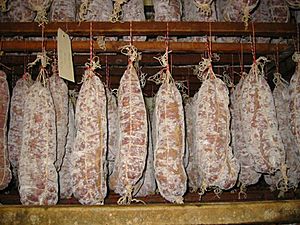Fermented sausage facts for kids
A fermented sausage, also called a dry sausage, is a special type of sausage. It's made by salting chopped meat to remove water. This process also lets good bacteria grow. These bacteria help create yummy flavors and keep the sausage safe to eat.
Contents
What is Fermented Sausage?
Fermented sausages are unique because they use helpful tiny living things, called bacteria, to change the meat. These special bacteria, like Lactobacillus and Leuconostoc, eat the sugars in the meat. When they do this, they make something called lactic acid.
Lactic acid does two important things. First, it gives the sausage a great flavor. Second, it makes the sausage a bit sour, which lowers its pH level. This lower pH (from about 6.0 to 4.5–5.0) stops bad bacteria from growing. This means the sausage stays fresh and safe for a long time without needing a fridge right away.
This process becomes even stronger as the sausage dries. As water leaves the sausage, the salt and sourness become more concentrated. This helps preserve the sausage even more.
How is Fermented Sausage Made?
Making fermented sausage involves several key ingredients and steps. Each part helps create the final delicious and safe product.
Key Ingredients
The main things you find in a fermented sausage are:
- Meat (like pork or beef)
- Fat
- Special bacteria (called a bacterial culture)
- Salt
- Spices (for flavor)
- Sugar
- Nitrite
Nitrite is often added to fermented sausages. It helps stop very harmful germs from growing. Some traditional sausage makers, however, choose not to use nitrites. Sugar is important because it feeds the good bacteria. This helps them make lactic acid during the fermentation process.
The Fermentation Process
The fermentation process can take from about 18 hours to three days. How long it takes depends on the temperature where the sausage is stored. Colder temperatures mean the fermentation will take longer.
Sometimes, a white mold and yeast grow on the outside of the sausage as it dries. This might sound strange, but this mold is actually a good thing! It adds to the sausage's flavor. It also helps prevent any harmful bacteria from sticking to the sausage.
Types of Fermented Sausage
There are two main kinds of fermented sausage. They are often found in different climates.
- Dry Sausages: These are common in warmer places, like countries around the Mediterranean Sea such as Italy, Spain, and Portugal. These sausages have less water (about 25–35%) and more salt (over 4%). Because of this, they can be stored safely at room temperature.
- Semi-Dry Sausages: These are usually found in cooler, more humid places, like Germany in northern Europe. They have less salt (around 3%) and more water (40–50%). Because of the higher water content and humid climate, they don't dry out as much. They might need to be kept in a cooler place.


